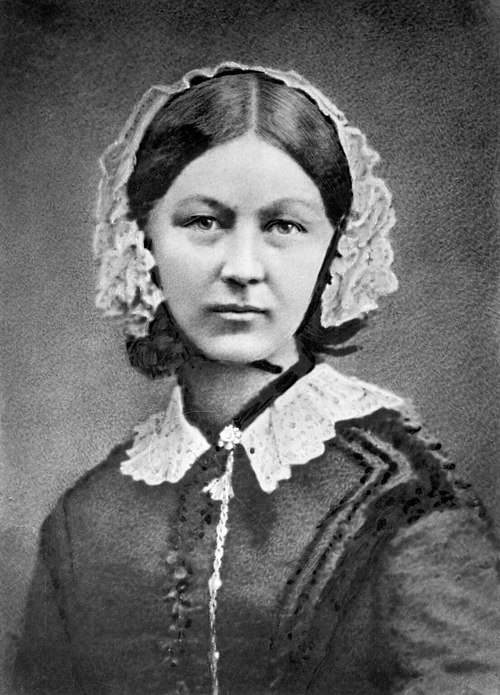
What did Florence Nightingale do? She managed to improve hospital hygiene, made nursing into a profession, used statistical analysis, and became the first female member of the Royal Statistical Society.
Florence Nightingale was born in 1820. She was British, but she was born in Florence, Italy, during a family tour of Europe, hence her name. She was born into a wealthy and very liberal family, which is how she was able to be so well educated and to travel through so many countries in Europe.
Florence Nightingale is most well-known for her work in the Crimean War and in nursing. This was a war between the Russian Empire on one side and the Ottoman Empire, France, and Britain on the other side between 1853 and 1856. It was the war that marked the end of the Russian Empire and pretty much the Ottoman Empire as well. It was also famous for having the first war correspondent. The extension of the telegraph to the area made it possible to report on what was happening and get it back to Britain within an hour. It had never been possible to hear about a war almost in real time before. Still, the things the Crimean War is mostly remembered for are Tennyson’s “The Charge of the Light Brigade” poem and Florence Nightingale.
Florence Nightingale became a nurse when she was 30 years old. She was travelling through Europe, and she says that she received a call from God when she was in Thebes. She received four months of medical training in Germany and found a position in a Harley Street hospital, which catered for fairly well-off patients. Her father gave her an income, so she could work at whatever she wanted, which was useful because nursing was pretty much a voluntary profession at the time.
When the Crimean War started, Florence Nightingale led a team of 38 volunteer nurses and 15 catholic nuns to the Selimiye Barracks, in Scutari, Balaklava, in the Crimea. This was in the Ottoman Empire at the time, but is in Turkey today. It is also why there are four hospitals in Turkey with Florence Nightingale’s name on them. When they arrived, they found terrible conditions for the injured soldiers. This is borne out by the figures. In the war, 20,240 French soldiers were killed in fighting, and a further 75,375 died after the fighting finished. For Britain, 4,602 died in the fighting and 17,580 died after the fighting. That type of figure can be seen in any war at the time. The American Civil War was only 10 years after the Crimean War, and in that 200,000 died in the fighting and about 400,000 died afterwards. Not all of those died because of disease and infection, but it was a lot.
Florence Nightingale did six things to drastically alter the situation. She changed the water source to make sure that it was clean. She had the sewers and the drains cleaned. She had the bedding of the patients thoroughly cleaned and made it so they didn’t reuse dirty blankets. She tried to get the patients nutritious food. She made all of her staff wash their hands regularly. And she provided comfort to the patients. She wouldn’t have known why all of these things helped, but they did. The idea that microorganisms caused and passed these diseases wouldn’t be proven until roughly 30 years after the Crimean War. In this one hospital alone, Florence Nightingale was able to bring the death rate down from 42% to 2%.
This is mostly what Florence Nightingale is remembered for. The British army took note, and soon many of its field hospitals and hospitals back home were improving. Nonmilitary hospitals improved as well. However, she did many other things as well. She managed to use her fame from the Crimean War to get the Nightingale Fund set up. This was swamped with donations, and she managed to set up the first ever training school for nurses. These trained nurses found work in many places, and overall medical care improved, thanks to Florence Nightingale.
She was also very good at explaining statistical information and using it to prove her arguments. She knew that people were dying in hospitals because of bad hygiene, poor nutrition, and overworked staff, so she set out to prove it. She collected data from army hospitals in the UK and in India as well. She presented this data very visually, using pie charts and various forms of bar charts that had only just been invented. She presented her data to several commissions and was pivotal in the changes that the medical institution enacted. In 1859, in honor of her work with statistics, she was elected the first female member of the Royal Statistical Society, and in 1874, the American Statistical Association.
These are only a few of the many things she did during her incredible life. This is what I learned today.
Sources
https://www.bbc.co.uk/bitesize/articles/zjfjxg8#zb8p3qt
https://www.nationalarchives.gov.uk/education/resources/florence-nightingale
https://en.wikipedia.org/wiki/Florence_Nightingale
https://en.wikipedia.org/wiki/Crimean_War
https://en.wikipedia.org/wiki/Selimiye_Barracks
https://pmc.ncbi.nlm.nih.gov/articles/PMC8639136/
https://en.wikipedia.org/wiki/Germ_theory_of_disease
By Henry Hering (1814-1893) – NPG x82368 from National Portrait Gallery, London, Public Domain, https://commons.wikimedia.org/w/index.php?curid=61520366
